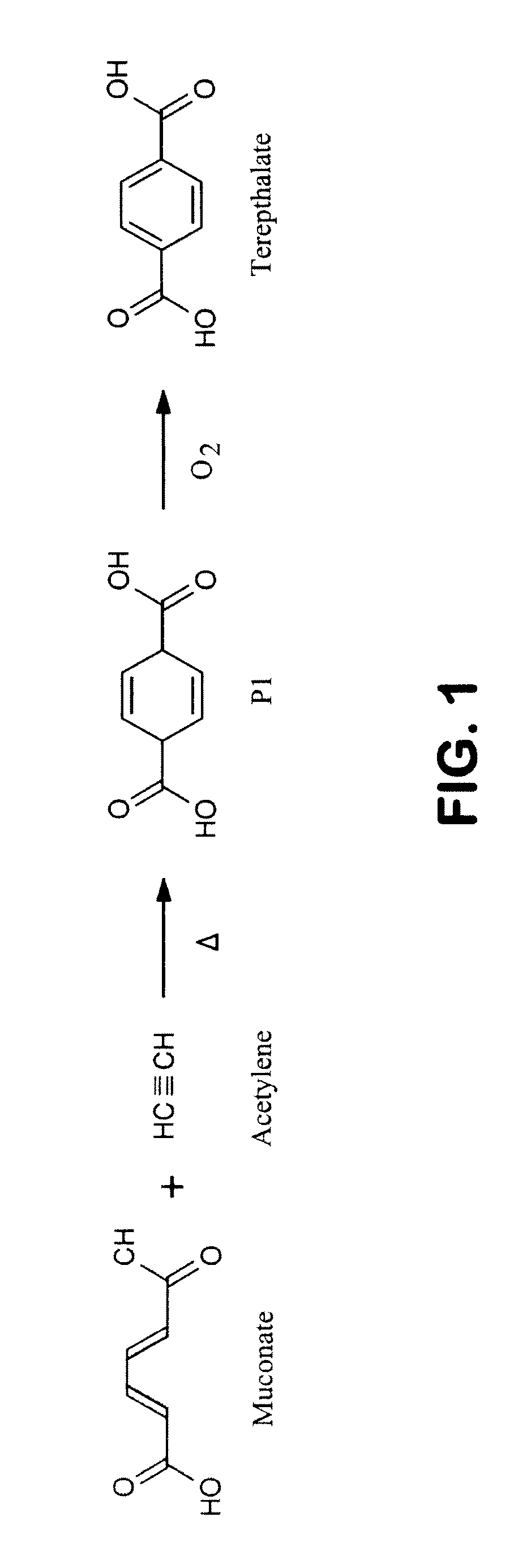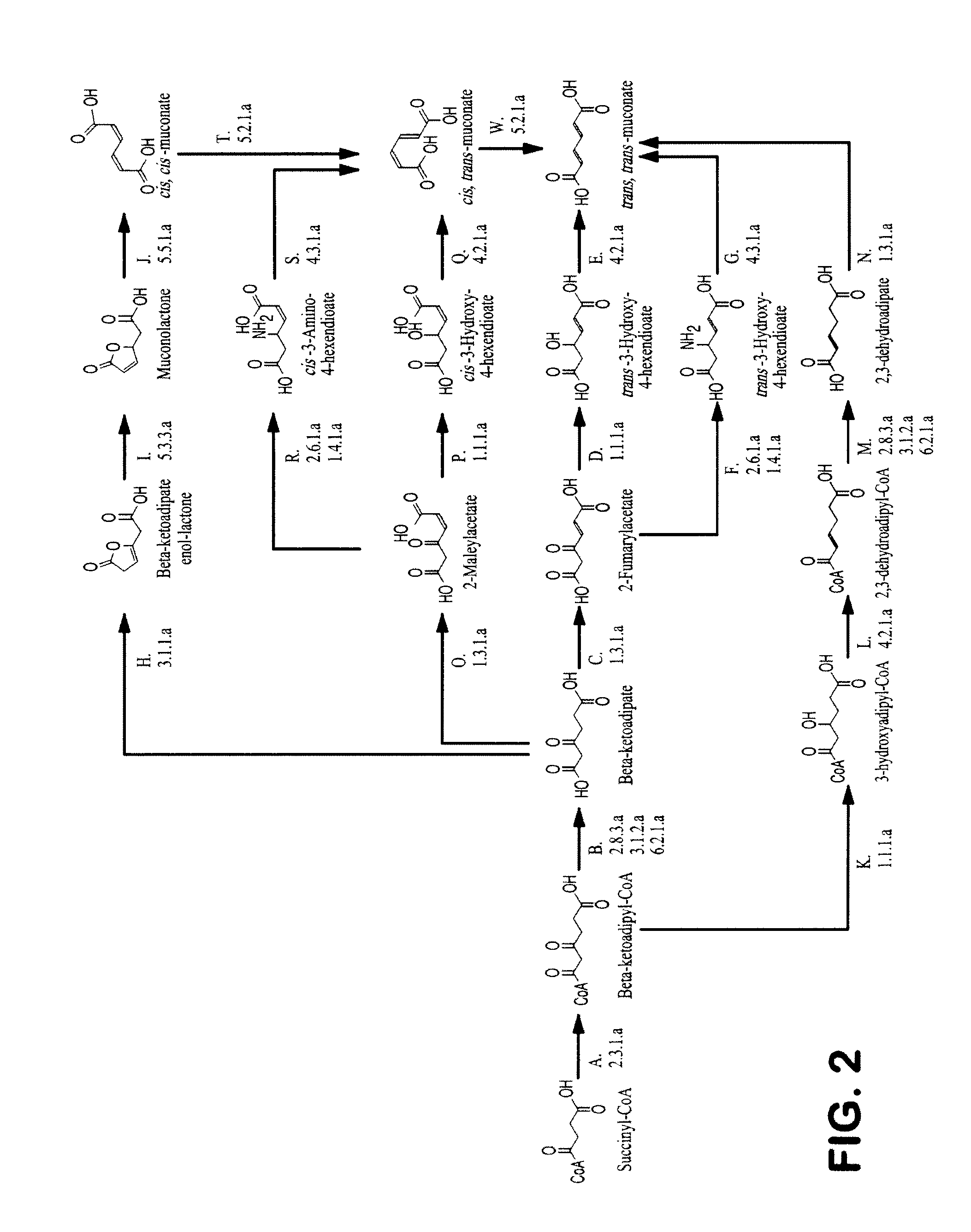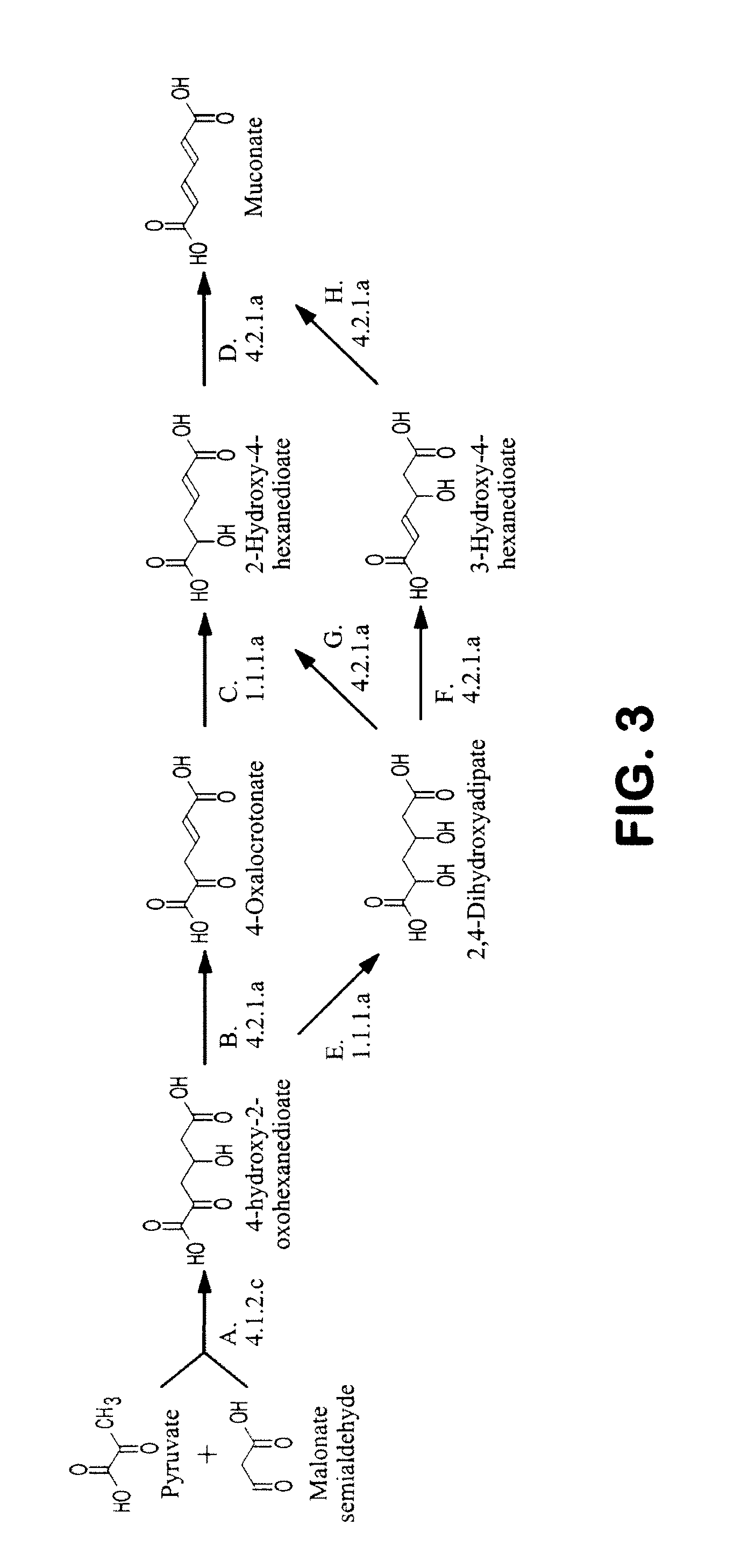Semi-synthetic terephthalic acid via microorganisms that produce muconic acid
a technology of terephthalic acid and microorganisms, which is applied in the direction of microorganisms, biochemistry apparatus and processes, organic chemistry, etc., can solve the problems of limited cis, cis isomer of muconate, and the properties of known enzymes
- Summary
- Abstract
- Description
- Claims
- Application Information
AI Technical Summary
Problems solved by technology
Method used
Image
Examples
example i
Demonstration of Enzyme Activity for Condensing Succinyl-CoA and Acetyl-CoA to Form β-ketoadipyl-CoA
[0250]This Example shows the identification of enzymes for the formation of beta-ketoadipyl-CoA from succinyl-CoA and acetyl-CoA.
[0251]Several β-ketothiolase enzymes have been shown to break β-ketoadipyl-CoA into acetyl-CoA and succinyl-CoA. For example, the gene products encoded by pcaF in Pseudomonas strain B13 (Kaschabek et al., J. Bacteriol. 184(1): 207-15 (2002)), phaD in Pseudomonas putida U (Olivera et al., Proc Natl Acad Sci USA, 95(11), 6419-24 (1998)), paaE in Pseudomonas fluorescens ST (Di Gennaro et al., Arch Microbiol, 188(2), 117-25 (2007)), and paaJ from E. coli (Nogales et al., Microbiology 153(Pt 2), 357-65 (2007)) catalyze the conversion of 3-oxoadipyl-CoA into succinyl-CoA and acetyl-CoA during the degradation of aromatic compounds such as phenylacetate or styrene. To confirm that β-ketothiolase enzymes exhibit condensation activity, several thiolases (Table 53) wer...
example ii
Preparation of Terepthalate from Acetylene and Muconate
[0253]This Example provides conditions for the thermal inverse electron demand Diels-Alder reaction for the preparation of PTA from acetylene and muconate.
[0254]A lab-scale Parr reactor is flushed with nitrogen gas, evacuated and charged with (1 equivalent) trans, trans-muconic acid and (10 equivalents) acetylene. The reactor is then heated to 200° C. and held at this temperature for 12 hours. An initial pressure of 500 p.s.i.g. is applied. The reactor is then vented, exposed to air and cooled. The contents of the reactor are distilled at room temperature and pressure to yield volatile and nonvolatile fractions. The contents of each fraction are evaluated qualitatively by gas chromatographic analysis (GC-MS).
[0255]For quantitative analysis, standards of the starting materials and the expected products, cyclohexa-2,5-diene-1,4-dicarboxylate and terepthalate, are prepared. A known amount of cyclohexane is mixed with a known amount...
example iii
Preparation of a Muconate Producing Microbial Organism, in which the Muconate is Derived from succinyl-CoA
[0256]This example describes the generation of a microbial organism that has been engineered to produce muconate from succinyl-CoA and acetyl-CoA via beta-ketoadipate, as shown in FIG. 2. This example also provides a method for engineering a strain that overproduces muconate.
[0257]Escherichia coli is used as a target organism to engineer a muconate-producing pathway as shown in FIG. 5. E. coli provides a good host for generating a non-naturally occurring microorganism capable of producing muconate. E. coli is amenable to genetic manipulation and is known to be capable of producing various products, like ethanol, acetic acid, formic acid, lactic acid, and succinic acid, effectively under anaerobic, microaerobic or aerobic conditions.
[0258]First, an E. coli strain is engineered to produce muconate from succinyl-CoA via the route outlined in FIG. 2. For the first stage of pathway c...
PUM
| Property | Measurement | Unit |
|---|---|---|
| Mass | aaaaa | aaaaa |
| Digital information | aaaaa | aaaaa |
Abstract
Description
Claims
Application Information
 Login to View More
Login to View More - R&D
- Intellectual Property
- Life Sciences
- Materials
- Tech Scout
- Unparalleled Data Quality
- Higher Quality Content
- 60% Fewer Hallucinations
Browse by: Latest US Patents, China's latest patents, Technical Efficacy Thesaurus, Application Domain, Technology Topic, Popular Technical Reports.
© 2025 PatSnap. All rights reserved.Legal|Privacy policy|Modern Slavery Act Transparency Statement|Sitemap|About US| Contact US: help@patsnap.com



